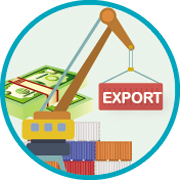 It is time to seriously examine the link between the returns from the country's industrial sector and the huge sums of money dished out every year in the form of duty exemptions and a host of other fiscal benefits by the government. A report published in a local daily on the various fiscal incentives given to various export sectors in the recent years shows that the amount is astronomical, and so the immediate reaction of a conscious citizen is likely to be the obvious: what the economy gets in return, or is it worth parting with huge NBR revenue that otherwise would go to the state coffer. The government handed out around Tk 1.47 trillion in the form of tax exemptions at import stage to various sectors since 2014-15 until January last. The amount of tax waived is nearly half the current fiscal's total tax collection target of Tk 2.96 trillion. The aforementioned report, quoting data from various government sources, said the volume of taxes in the form of exemptions has been increasing every year since FY 15.
It is time to seriously examine the link between the returns from the country's industrial sector and the huge sums of money dished out every year in the form of duty exemptions and a host of other fiscal benefits by the government. A report published in a local daily on the various fiscal incentives given to various export sectors in the recent years shows that the amount is astronomical, and so the immediate reaction of a conscious citizen is likely to be the obvious: what the economy gets in return, or is it worth parting with huge NBR revenue that otherwise would go to the state coffer. The government handed out around Tk 1.47 trillion in the form of tax exemptions at import stage to various sectors since 2014-15 until January last. The amount of tax waived is nearly half the current fiscal's total tax collection target of Tk 2.96 trillion. The aforementioned report, quoting data from various government sources, said the volume of taxes in the form of exemptions has been increasing every year since FY 15.
Despite the soaring cash incentives against export receipts over the years, many sectors could not make their mark, bringing in limited results for the government's diversification initiative. Only the garment sector has consistently fared well, turning Bangladesh as the second-largest apparel supplier in the world. The sector accounts for about 85 per cent of the country's exports as well. Potential sectors such as jute and jute goods, leather and leather goods, agro-processing and frozen foods have not been able to emulate the feat achieved by the garment sector.
The central bank data show that the subsidy amount stood at Tk 8,689 crore in the last financial year 2023-24, slightly down from Tk 8,784 crore from a year before. Currently, 43 sectors receive taxpayer-funded cash support, with the maximum rate standing at 15 per cent and the minimum rate at 0.5 per cent.
There has not been any methodical research on the amount of money the country loses vis-à-vis the gains from exporting or the direct or indirect benefits enjoyed by the consumers. Moreover, there are instances of abuse -- allegedly significantly -- in enjoying tax holiday by some exporting sectors.
It is true, quantifying the benefits of the economy from such exemptions is not easy. Attempts, however, may be made to see whether an enterprise gained, and if yes, how much from fiscal incentives and duty exemptions in respect of some broad parameters such as boosting productivity, product diversification, overseas marketing and export earning.
It is a regular feature that businesses in the country are always eager to look up to the government for incentives -- mostly in the form of tax waivers. The government, too, is accustomed to viewing such waivers as trade facilitating actions that can lower costs, boost production and increase exports. This is a historical phenomenon prompted initially by the need of state support, especially fiscal support, for infant industries to compete with imported goods in the domestic market and also to find an edge in overseas markets. However, although the manufacturing scenario is changing a good deal over the past decades, the culture of incentivising by fiscal concessions is still quite pervasive. What appears to be behind this could perhaps be the perception that facilitation essentially calls for fiscal rebate, concessions and even outright waivers. But this is not necessarily the case, because facilitation through various infrastructure upgrading, removing bureaucratic bottlenecks, subsidised transportation cost, expansion of credit facility etc can also weigh substantially in rendering an enterprise better equipped.
Economists and trade experts are in favour of phasing out the subsidies as a measure of preparedness for the post-LDC graduation period after 2026. Some steps have been taken in that direction. The imminent graduation and persisting pressure on the state coffer amid low tax collections prompted the government to cut cash subsidies for almost all sectors in February this year with a view to gradually bringing down the rates and protecting exporters from any shock that may emanate in the event of a sudden withdrawal of the cash support. The highest cash incentive rate has been reduced to 15 per cent from 20 per cent for most sectors. Only four sectors - diversified jute products, vegetables, fruits and products in the agro-processing sector, potatoes, and halal meat and processed meat exporters -- will qualify for the top rate. Experts view that the rates need to be revised every year in order that the sudden shock from withdrawal after 2026 may not be too harsh for exporters.
Since incentives do not necessarily mean monetisation, it is imperative that the government works out a mechanism for meaningful export facilitation as mentioned above. Many developing countries, debarred from providing subsidies, facilitate their export industry in various ways that help exporters so much to make up for cash hand-outs.
wasiahmed.bd@gmail.com
© 2026 - All Rights with The Financial Express
